Right on schedule, the third week of April has climbers on both sides of Everest moving to the higher camps in the quest of adjusting their bodies to higher altitudes.
For many climbers, they will have trouble adjusting as Camp 1 in the Western Cwm on the Nepal side is 19,500 feet and on the Tibet side, Advanced Base Camp is even higher at 21,300 feet. The first night at altitude is always horrible.
Normal Season Thus Far
Overall the season continues to progress normally with no major issues. The routes are being managed well on the Nepal side with the rope fixing teams preparing to set the route on the Lhotse Face to Camp 3.
Over on the Tibet side, progress is good as well. Teams left for Interim Camp on their way to Advanced Base Camp. The Tibetan rope fixers are on duty and preparing to get the route to the North Col as soon as this weekend.
It has been windy on the Nepal side but that has calmed down. Climbers are reporting the north side base camp is cozy but their -20F sleeping bags are way too warm!
Into the Cwm
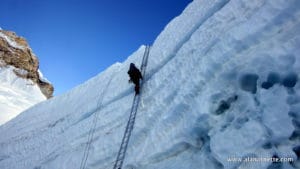
The activity is strong in the Icefall and Cwm this week. Sherpas make up the majority of the traffic but there is a huge difference with the foreigners or members.
The Sherpas will wake up at 2:30 am to have a strong concoction of roasted barley porridge called tsampa, a wheat paste known as syan, and servings of Tibetan Tea. Westerners have no chance of digesting this meal so early and force down toast, egg and coffee.
It is common for the Sherpas to leave EBC with a 30 pound load, climb through Icefall to Camp 1 or even Camp 2 and be back for the member’s breakfast at 8:00 am. For the mere mortals, on this first trip to Camp 1, it will take 5 to 7 hours and they will be exhausted once they arrive.
IMG’s Classic team consisting of 14 members and the same number of Personal Sherpas arrived at Camp 1 on 18 April. They will spend two nights there before moving to Camp2 for another two nights.
It will be a few days before climbers return to base camp to post reports on the climbing conditions, but my close friend Jim Davidson gave me a hint with a short message:
… we are at 19,800 feet. Took six hours. Some very sketchy moves in icefall. Feel pretty good
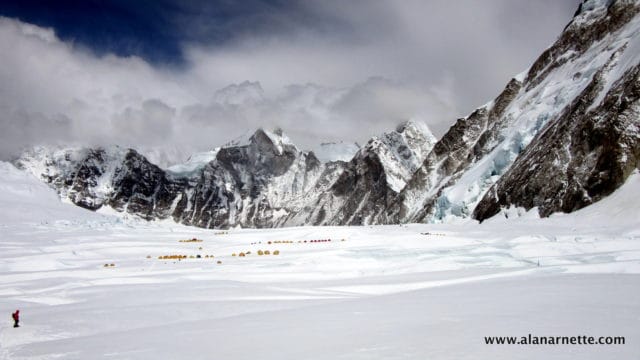
Camp 1 Heat
The stay at Camp 1 will be miserable. The climbers arrive at 8:00 am just as the sun begins to hit the tents. They are tired, questioning their resolve as they crawl into their tents. They spread out their personal gear along with their -20F down sleeping bag and lie down.
Within minutes, they are sweating, horribly hot, like in a sauna but no humidity except for the sweat now forming off their nose. They shift to reduce the body surface area against the down bag. They roll again. OMG, this is horrible! Who said it would be like a summer day in Atlanta but this at 20,000 feet in the Western Cwm?
You look over at your tent mate, he is just as miserable and they makes you feel better.
All of a sudden your Personal Sherpa appears at the door. “Hot tea?”
To ABC
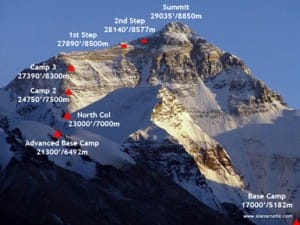 On the Tibet side, many teams are now reported to be at Interim Camp. This is a very uncomfortable place halfway between base camp and Advanced Base Camp (ABC). Because ABC is pretty high, 21,300’/6400m, climbers split the first sorte’ from the 17,000′ base camp and usually only spend one night at Interim during the entire climb and that is now.
On the Tibet side, many teams are now reported to be at Interim Camp. This is a very uncomfortable place halfway between base camp and Advanced Base Camp (ABC). Because ABC is pretty high, 21,300’/6400m, climbers split the first sorte’ from the 17,000′ base camp and usually only spend one night at Interim during the entire climb and that is now.
It takes between five to six hours to reach it the first time. Later on, after acclimatization, teams will go all the way to ABC is that same time. To compare this to the south side, Camp 1 is at 19,500’/5943m and Camp 2 at 21,000’/6400m
I am getting reports of good communications at base camp on the north. Andy Anderson said:
I am using an iPad and have 3G for both China Unicom and China Mobile. Phones may have 4G. It is quite fast internet at any rate. I FaceTime with family in the US without any issue.
Ricky Munday with SummitClimb made a nice long post as they prepare to move to Interim Camp. It is the Blog of the Day.
Yesterday was a good day to stretch the legs. After a broken sleep, I set out with George and Alan to walk up the valley part of the way towards interim camp. We walked at a slow but steady pace, and I wore a face mask with Olbas Oil inside to keep my airways clear. I know George well from previous trips, and Alan is a 50-something Scot based near Cambridge who has previously climbed Cho Oyu with SummitClimb.
There wasn’t much to see on the walk up the valley, but there were some strange Earth formations, almost like penitentes. We were passed by a few Sherpas carrying loads up to interim and Advanced basecamps, and also by a yak train moving down the trail with the Chinese team. The progress of all other teams on the mountain is highly dependent on the Chinese establishing the fixed ropes from below the north Col to the summit. Hence, we’re in no rush to move up the mountain. In fact, some teams have yet to arrive at basecamp, although more are arriving each day.
Climb the North Now
The Chinese have provided electricity at base camp, and supposedly banned generators. This comes as no surprise as the Chinese plan to build a “Mountaineering Center” near base camp.
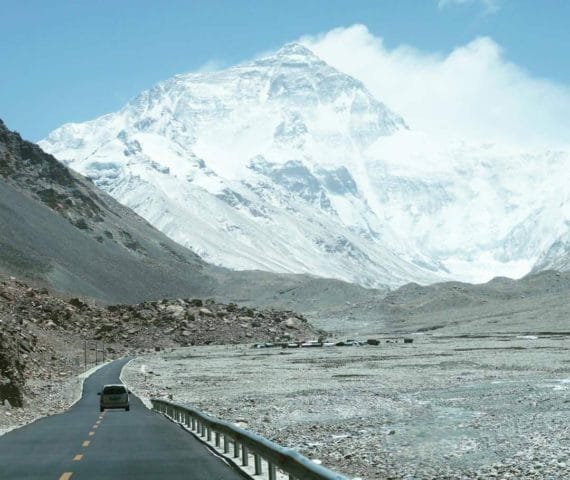
As I reported late last year, China will invest $14.7 million in a mountaineering museum near the Tibetan township of Gangkar (Gonggar County) – about 20 miles from the traditional Everest Base Camp which is used as a base for attempts on Everest from Tibet. The new Center is planned to open in 2019 – three years before the Olympics.
According to the China Daily report, the center will cover 900,000-sq.-ft. – the equivalent of 3.5 Super Wal-Marts – and support mountaineers, skiers, paragliders and tour guides, plus medical services, travel agencies and a helicopter rescue base.
North side advocates promoting their business will hail this as advances in safety and support, primarily due to having helicopters for rescues. I agree that safety may be improved but we have already seen what “easy” helicopter access has done in Nepal. Marginal climbers assume they can phone a flight when they get in trouble. Last year, there were 18 climber evacuations from Camp 1 and 2 by helicopter just from one helicopter company and there are several that work Everest. The major symptom listed was exhaustion.
For those looking for a quiet, remote Everest experience on the Tibet side, go now because Everest Disneyland is on the horizon
Climb On!
Alan
Memories are Everything

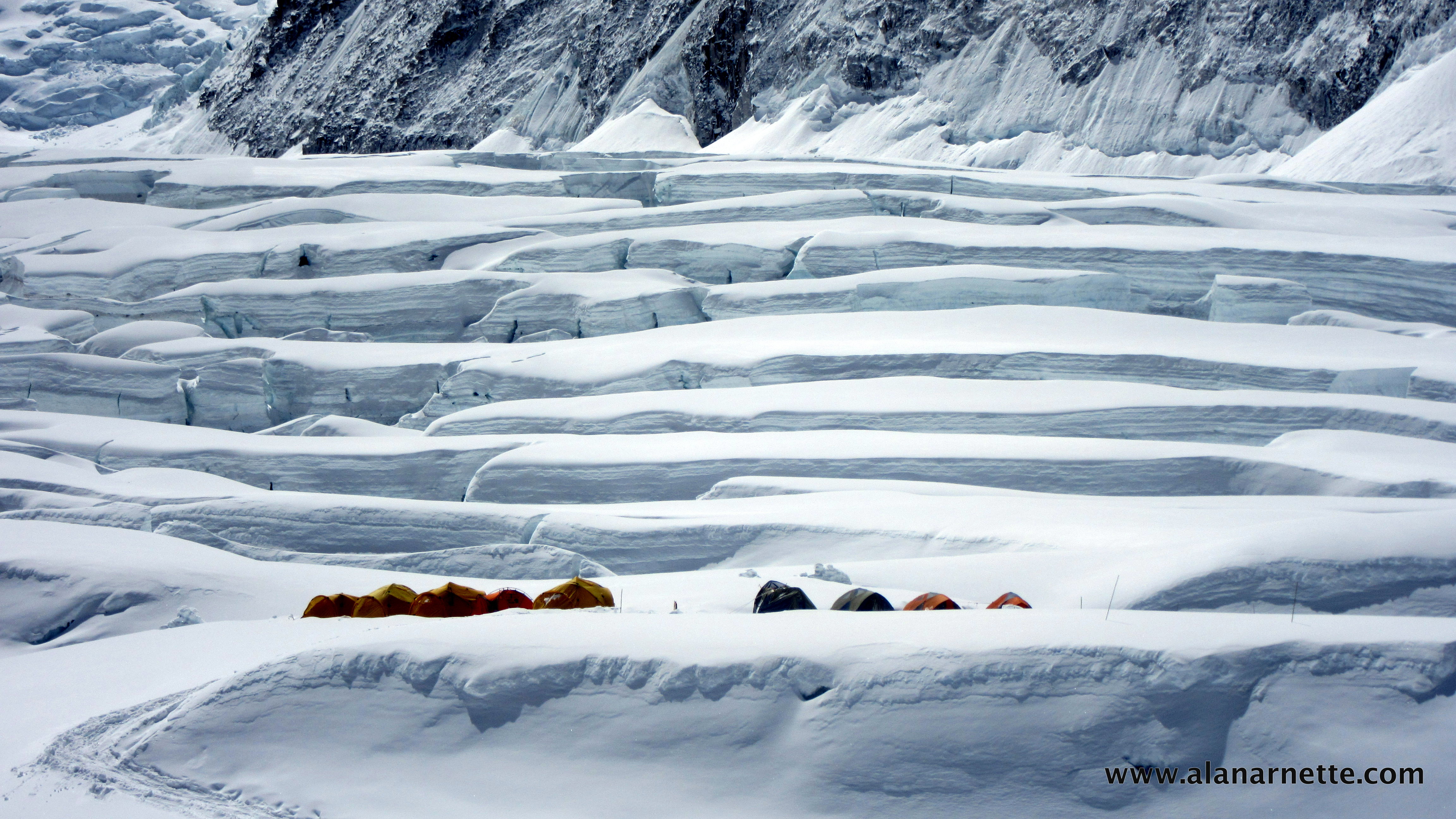


5 thoughts on “Everest 2017: Into the Western Cwm”
Hello, Alan! I am an ELA teacher in New York City and our 7th grade class will be following your blog as part of our unit on Survival Stories. We’re looking at summiting Everest as “Man vs. Nature” (though I’m sure there’s a fair bit of Man vs. Self in there!), and each student is picking a “climber pal” from your links to follow, as well. We wish you and everyone there a safe and successful season and look forward to reading updates!
Fantastic! Welcome aboard and Climb On!
Hi Alan,
When they say that the icefall moves 1 meter a day, is it horizontally or vertically? Does it affect the fixed lines or ladders? How does it affect the climb through there overall? As always, thank you for your great posts!
Hi Adina, read my recent post on the Icefall for details but movement as in all glaciers is downhill driven by gravity. The ladders can fall into crevasses and have to be reset or replaced. The movement is so slight, climbers don’t feel it but it does make towering seracs collapse with no warning.
Climbers avoid the Icefall when the sum is hitting it so they climb in the early morning hours from 2:00 am to 7 am.
http://www.alanarnette.com/blog/2017/03/15/everest-2017-why-is-the-khumbu-icefall-so-dangerous/
Everest disneyland… =)
Comments are closed.